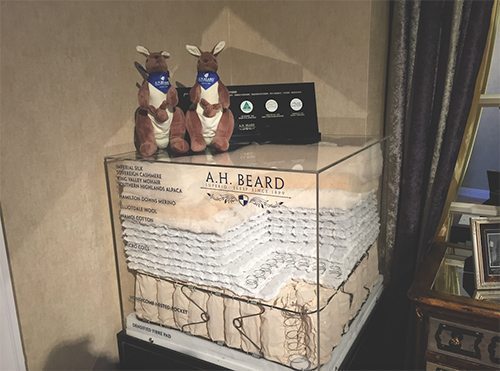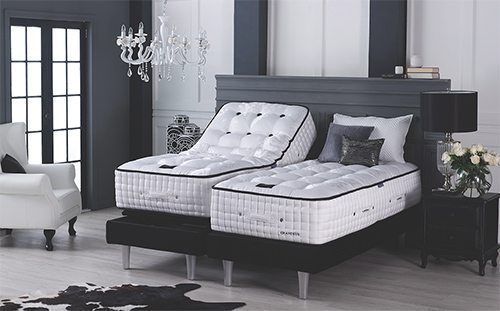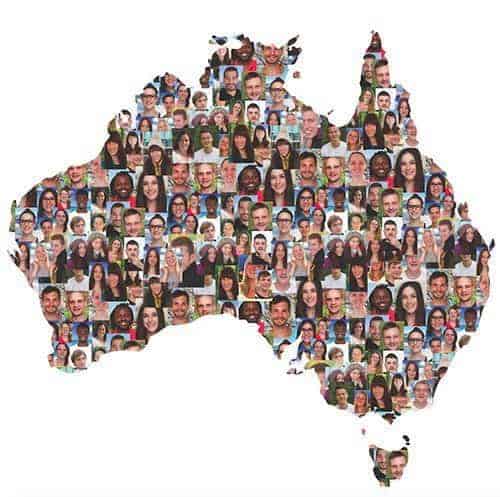Australian mattress maker A.H. Beard eyes international growth for its high-end bedding lines
BY DOROTHY WHITCOMB

A.H. Beard Pty. Ltd., based in Padstow, New South Wales, Australia, has been a family-owned and operated manufacturer since 1899. Current family members include (back row, from left) Garry Beard, Lexi Bugden, Allyn Beard, Christine Beard, Matthew Beard, (front row) Pat Beard, Sally Schofield and baby Paisley.
Deeply rooted in Australian history, A.H. Beard Pty. Ltd. is a 116-year-old family business with a broad reach and a global perspective. Having secured its place as a leader in Australia’s high-end bedding market, the company is building a framework for expansion into Asia and Europe. It’s pursuing this goal in the same way it built its domestic business—carefully, methodically and with an eye toward securing the company for future generations.
Headquartered in Padstow, New South Wales, A.H. Beard has roots in a venture founded by Enoch Beard in 1899. Then called the Australian Bedding Mill, it supplied immigrants with palliasses and tufted horsehair mattresses as they disembarked from ships.
In 1926, a fire destroyed the mill and, with it, the family’s fortunes. Albert Beard, Enoch’s son and the grandfather of the company’s current leadership, took up the challenge of rebuilding the company—one handmade mattress at a time.
Today, the company is led by the fourth generation of the Beard family. Brothers Garry Beard, who is chairman, and Allyn Beard, director, hold the key executive positions. Three fifth-generation family members also are active in the company.
Allyn Beard credits two factors for A.H. Beard’s survival and growth as a family business. “The keys are succession planning and a company vision that grew from the input of both senior management and family stakeholders not active in the business,” he says.
A framework for turning vision into reality was developed by management and continues to serve the company well. “We amended our articles of incorporation to reflect the family nature of the business,” Beard says. “That takes away many of the small issues that tend to fester in a family. A plan of how to reach our vision was created and is updated every five years. All family members are also invited to an annual family council meeting, where those plans and the condition of the business are reviewed.”
National, international growth
A.H. Beard produces between 1,000 and 1,500 beds daily in six facilities spread throughout Australia and one based in Auckland, New Zealand. The company’s growth trajectory initially was fueled by the expansion of one of its key accounts, Harvey Norman, a large furniture, bedding and consumer electronics retailer.
“They are an $6 billion* company, and we followed their expansion throughout Australia,” says Beard, who has been a member of the International Sleep Products Association Board of Trustees since 2012.
In the 1990s Beard began a program of strategic acquisitions that boosted sales once again. Its first acquisition, Suparest Bedding, allowed the company to expand into southern Australia. That acquisition came with a King Koil license, which set the stage for further growth.
“There were other companies around Australia that were also King Koil licensees,” Beard says. “We gradually bought them all up and now A.H. Beard is the sole King Koil licensee in Australia and New Zealand.”
The company claims 17% of the Australian and New Zealand bedding markets, but sees its position in those arenas as a bigger indicator of success. “What we’re most proud of though is that we have the highest average unit value in Australia,” he says.
“We go for the quality end of the market. ‘Improving Lives Through Better Sleep’ is more than a catch phrase with us. It underpins everything we do. Making promotional beds doesn’t jibe with that,” he adds. (See related story below.)
Prior to the global recession, this commitment to quality netted A.H. Beard a 25% to 30% annual growth rate. Since 2008, however, growth has slowed to 5% to 10% annually. With the Australian economy still struggling to get its post-recession footing, A.H. Beard has begun to look outside its own borders for ways to spur more robust growth.
In 2010, the company signed a licensing agreement with Norfolk, Virginia-based Paramount Sleep to produce the A.H. Beard brand in the United States. Three years ago, the company began exporting mattresses to China, where it sells through two retail chains—Shanghai Green and Royal Furniture. Shanghai Green currently operates 24 A.H. Beard branded stores with plans to open two more by year’s end. Royal Furniture sells Beard product in 50 of its stores.
Wide array of lines

A.H. Beard mattresses are made from Talalay latex, gel-infused and structured-gel memory foams, and high-resilience foam. In addition, the beds feature a range of technologically advanced coil systems.
The company produces five product ranges (referred to as lines in the United States) and exclusive ranges for its key retail partners. “The number of models is forever changing but is currently about 200 SKUs,” Beard says.
Retail prices for King Koil queen sets begin at $999 and top off at $6,999. Prices for Domino sets run from $799 to $3,999, while Health Rest, which includes an adjustable Ergomotion foundation, ranges from $2,499 to $4,999. Nature’s Rest, a latex range, sells from $2,499 to $5,999. The company’s customizable line, Signature, opens at $10,000 and closes at $70,000.
“Each range includes mattresses made from Talalay latex, gel-infused and structured-gel memory foams, and high-resilience foam,” Beard says. “In addition to standard spring constructions, we use our own patented spring system, Reflex, which features a smaller diameter support spring placed between pockets. We also have an extensive range of pillows that coordinate with each of our premium brands.”

Signature, A.H. Beard’s customized line, combines handmade craftsmanship with technological innovation. Prices range from $10,000 to $70,000.
A.H. Beard owns international rights to the iComfort brand. “In 2006, both A.H. Beard and Serta independently came up with the iComfort name,” he says. “Serta only registered for the United States and Canada, whereas we applied for numerous countries. Since Serta’s North American application preceded ours, it was successful there and we were successful in all other countries. In 2012, we came to an agreement to license our iComfort international trademarks to Serta so it could sublicense it.”
Today, when Beard surveys his company, he is confident that it is well positioned for continued growth. “We’re passionate about the bedding industry,” he says. “We’ve been around for over 100 years, have sound dynamics in the family and have built up intellectual property that we can leverage and license. The A.H. Beard brand is already in the U.S. and China, and we intend to take it to the United Kingdom and parts of Asia. Our hope is that the next generation will be managing a global business.”
More than a catchy phrase: Tagline emphasizes sleep-health connection
Australian manufacturer A.H. Beard Pty. Ltd. is on a mission to change lives—one night at a time. Three years ago, the company revamped its marketing program, placing the health benefits of sleep center stage. The change, Director Allyn Beard says, was more than a savvy marketing move. It was a way to begin a conversation with consumers that elevates the importance of sleep in purchasing decisions.
When marketing programs change, taglines frequently do, too. So it was with A.H. Beard. “Superior Sleep Since 1899” now is “Improving Lives Through Better Sleep,” which, Beard says, is pivotal to the company’s mission.
When the company revamped its website in 2012, it put sleep in the forefront by launching the “A.H. Beard Six Week Sleep Challenge.” The challenge, which is currently in its fifth round, invites consumers to sign up for a free program of customized tips for improved sleep.
After taking a brief survey, participants discover which of four problematic sleep categories best describes their situation. They then receive weekly tailored tips for improving their sleep.
An online forum in which participants can compare their experiences with others taking the challenge supplements these tips. Those in need of more focused advice can use the forum to consult with Carmel Harrington, a research scientist who works as a sleep consultant for corporate health and well-being programs, schools, and brands both in Australia and internationally.
To date, 40,000 people have taken the sleep challenge, with 44% of participants reporting increased sleep quality. “We’ve had tremendous feedback from consumers, many of whom have advised that it has transformed their sleep and their lives,” Beard says. “Mission accomplished!”
How U.S., Australian bedding markets differ

The range of sizes available might be the first clue that there are meaningful differences between mattress production in the two countries. Although the dimensions of full- and queen-size beds are the same in both, manufacturers in Australia offer consumers more choices when it comes to single and king-size mattresses.
Singles come in three sizes. The standard single measures 36 inches by 74 inches, the long single is 36 inches by 80 inches, and the king single 42 inches by 80 inches.
Consumers also can choose from three king mattress options. In Australia, the standard king is 72 inches by 80 inches, the super king is 80 inches by 80 inches, and the New Zealand king is 66 inches by 80 inches.
This proliferation of sizes adds another layer of complexity to a production system that already is challenged by the sheer size of the country it serves.
“Australia has 23 million people spread over a landmass the size of North America,” says Allyn Beard, director of A.H. Beard Pty. Ltd. Even for his company, which has more than 700,000 square feet of manufacturing space spread strategically throughout the country, this can mean a four- to five-day lead time for delivery to some customers.
Sticker shock might be the first real eye-opener for the hypothetical American consumer. “On average, wage costs are about twice what they are in the United States, as are the average prices for beds,” Beard says.
Cultural differences also impact production schedules and costs. “In Australia, the normal working week is 38 hours, and employees generally receive four weeks of paid vacation, with an additional 11 public holidays off work,” he adds.
The biggest challenge may be looming, however. “The new e-commerce, boxed-bed disruptor is just emerging in Australia,” Beard says.




